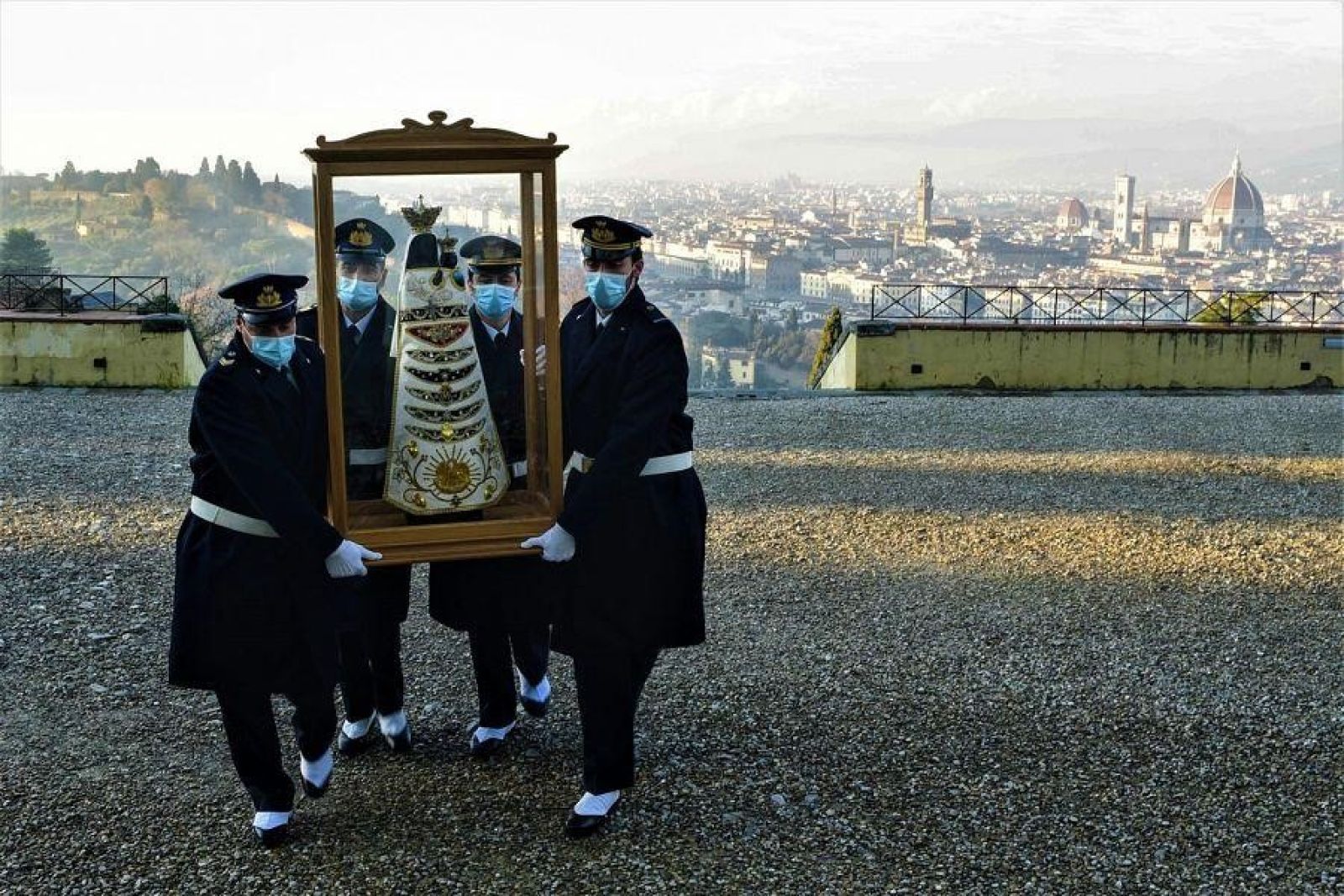The Itinerant Shrine and the Sacred Landscapes of Loreto
Public lecture followed by on-site workshop (25-27 May 2023) organized by Matteo Chirumbolo, Erin Giffin, Antongiulio Sorgini and Gerhard Wolf

A modern copy of the Madonna di Loreto is carried in procession to the church of San Miniato al Monte, Florence, on 18 December 2020 for the ‘Festa della Venuta’. Image courtesy of Aeronautica Militare.
The lecture examines the Santa Casa, or Holy House of the Virgin Mary, a relic in constant motion. Legend holds that at the end of the thirteenth century, a company of angels flew Mary’s small brick and stone house—the site of the Annunciation and Jesus’s childhood home—out of Nazareth before eventually depositing it in Loreto, in the Marche region of Italy. Over the ensuing centuries, the House prompted the movement of people to the sanctuary that was built to encompass it: migrant communities that had been excluded from other Italian cities came to settle in Loreto just as a growing number of Christians set out on pilgrimage to visit the miraculous incorporation of the Holy Land into Europe. As the site grew in prominence, it attracted artists from various places who produced opulent votive adornments in painting and sculpture. At the same time, the sanctuary became a point of transmission for devotional memorabilia, including prints, statuettes, ceramics, and tattoos. As the cult of the Holy House and its miraculous sculpture spread across the seventeenth and eighteenth centuries, so did architectural reproductions of the building, which emerged throughout Europe and as far afield as the Amazon Basin and modern-day Canada. Through contact with the original relic, or with one of its surrogates located across the globe, Loreto has continued to inspire devotional and artistic responses into the present day.
The evening lecture will investigate how a small town in the Italian hinterland became a central node in an expansive geographic network, discussing broader themes of mobility, migration and cultural contact, conversion, colonization, patronage, artistic and cultic reproduction, and the development and articulation of place, among others. The lecture also marks the beginning of a private workshop to be held in Loreto on 25–26 May, itself a follow-up to ‘The Itinerant Shrine: Art, History, and the Multiple Geographies of the Holy House of Loreto’, a conference held in June 2022 at the Courtauld Institute of Art in London. The workshop, bringing together twelve scholars working in a variety of disciplines and employing a range of methodological approaches, will serve as a steppingstone for an edited volume.
The lecture will be followed by closing remarks by Gerhard Wolf and a discussion with the workshop's participants and the audience.
Workshop participants include: Luisa Elena Alcalá (Universidad Autónoma de Madrid); Josip Belamarić (Institute of Art History – Center Cvito Fisković, Split); Ferruccio Botto (Scuola Normale Superiore, Pisa); Matteo Chirumbolo (The Courtauld Institute of Art/Kunsthistorisches Institut in Florenz–MPI, Florence); Francesca Coltrinari (Università di Macerata); Erin Giffin (Skidmore College, Saratoga Springs, NY); Mattia Guidetti (History of Islamic Art, Università di Bologna); Bianca Lopez (Southern Methodist University, Dallas, TX ); Margaret Meserve (University of Notre Dame, IN); Eelco Nagelsmit (University of Groningen); Emily Price (Newcastle University, Newcastle upon Tyne ); Antongiulio Sorgini (Johns Hopkins University, Baltimore); Gerhard Wolf (Kunsthistorisches Institut in Florenz–MPI, Florence).
24. Mai 2023, 18:00 Uhr
This will be a hybrid event.
Venue
Palazzo Grifoni Budini Gattai
Via dei Servi 51
50122 Firenze, Italia
To participate online please register in advance via Zoom: https://eu01web.zoom.us/meeting/register/u5Msf-uvpj0tE9F47ru7yqQPKd4WRPwSun76
After registering, you will receive a confirmation email containing information about joining the meeting.
Hinweis
Diese Veranstaltung wird durch Fotografien und/oder Videoaufnahmen dokumentiert. Falls es nicht Ihre Zustimmung findet, dass das Kunsthistorische Institut in Florenz Aufnahmen, auf denen Sie erkennbar abgebildet sein könnten, für die Veranstaltungsdokumentation und Öffentlichkeitsarbeit (z.B. Social Media) verwendet, bitten wir um eine entsprechende Rückmeldung.


